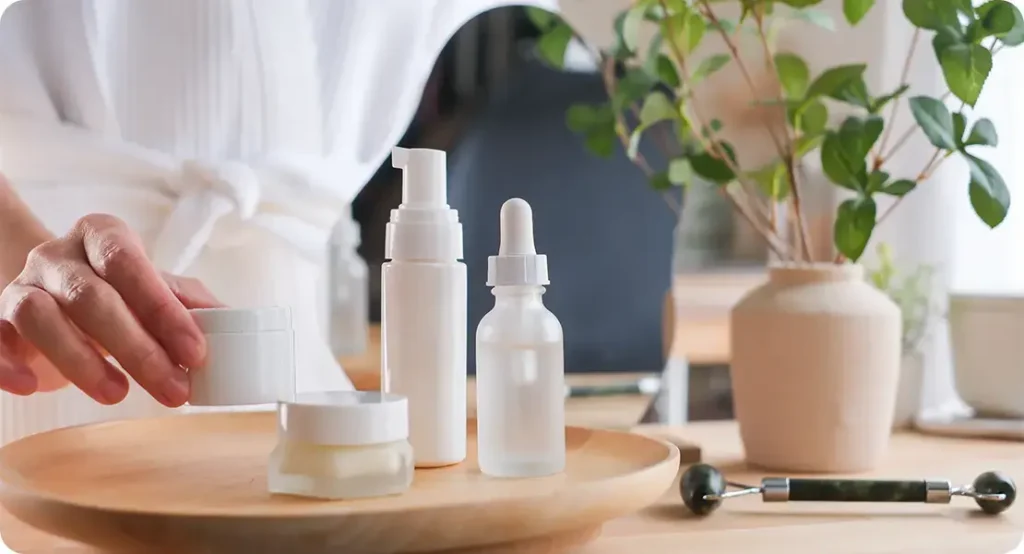If you’re anything like me, you’ve probably stood in front of the mirror wondering where those dark spots came from and why they seem to take forever to fade. Whether it’s that one stubborn mark left behind after a breakout, a patch of pigmentation that surfaced after a beach holiday, or new discolouration that seems to have appeared out of nowhere, dark spots have a way of stealing the spotlight from otherwise healthy skin. They don’t hurt, they’re not dangerous but they are incredibly frustrating.
The truth is, dark spots also known as hyperpigmentation are more common than you think, and they can show up for many different reasons. Maybe your skin reacted to inflammation after acne. Maybe years of sun exposure have started to catch up with you. Or perhaps hormonal changes during pregnancy or birth control triggered melasma. Whatever the cause, these changes in pigmentation can feel like an uphill battle, especially when no over-the-counter product seems to work fast enough.
But here’s the reassuring part: treating dark spots isn’t impossible. It just takes the right knowledge, the right products and sometimes, a little help from a dermatologist. While there’s no one-size-fits-all solution, modern dermatology offers a range of highly effective treatments tailored to your skin’s needs. From prescription creams and chemical peels to cutting-edge laser therapies and personalised skincare routines, there are more options than ever before to help you achieve clearer, more even-toned skin.
In this blog, we’ll take a closer look at the most common types of facial pigmentation like post-inflammatory hyperpigmentation, sunspots, and melasma and explain exactly how dermatologists approach each one. You’ll also find practical advice on prevention, daily skincare habits, and what to expect during treatment.
If you’ve ever felt discouraged or overwhelmed by your skin’s uneven tone, don’t worry you’re not alone. And with the right approach, progress is possible. By understanding what’s happening beneath the surface and taking consistent, targeted action, you can absolutely get your glow back.
What Causes Dark Spots on the Face?
Dark spots, or hyperpigmentation, are one of the most common skin concerns people face regardless of age, gender, or skin type. But before we talk about how to treat them, it’s important to understand why they show up in the first place.
At the core of all pigmentation issues lies one key substance: melanin. This is the natural pigment that gives your skin, hair, and eyes their colour. When melanin is evenly distributed, your skin tone looks uniform. But when your skin produces too much melanin in certain areas, that’s when dark spots start to appear.
So what causes this overproduction? Here are the main culprits:
1. Post-Inflammatory Hyperpigmentation (PIH)
If you’ve ever had a pimple that left behind a dark mark long after it healed, you’ve experienced PIH. This type of pigmentation develops after your skin has gone through some form of trauma or inflammation. Acne is the most common trigger, but PIH can also be caused by eczema, bug bites, scratches, burns, or even overly aggressive skincare (like chemical peels or harsh scrubs).
When your skin is injured or irritated, it tries to defend itself by producing more melanin. In darker skin tones where melanin-producing cells (melanocytes) are naturally more active this response is often stronger, which makes PIH more noticeable and longer-lasting. These spots can range in colour from light brown to deep black, depending on your skin tone and the severity of the inflammation.
2. Melasma
Melasma is a more complex and hormonally driven form of pigmentation. It typically shows up as large, blotchy patches of brown or grey-brown discolouration, often appearing symmetrically on both sides of the face. Common areas include the cheeks, forehead, bridge of the nose, chin, and upper lip.
Hormonal changes such as those that occur during pregnancy, while taking birth control pills, or during hormone therapy are the most common triggers. In fact, melasma is sometimes called “the mask of pregnancy” because it frequently develops in pregnant women.
However, melasma doesn’t stop there. Sun exposure can make it significantly worse by stimulating melanin production even further. Unfortunately, melasma is also one of the most stubborn forms of hyperpigmentation to treat, with a high chance of recurrence even after successful treatment. That’s why managing melasma usually involves both targeted treatment and long-term prevention strategies.
3. Sun Damage (Solar Lentigines)

If you’ve spent years enjoying the sun without using SPF or even just skipping sunscreen on a regular basis your skin will likely start showing signs of sun damage in the form of solarlentigines. These are flat, brown spots that usually develop in areas that get the most sun exposure, such as the cheeks, forehead, temples, and nose. They’re commonly referred to as age spots or liver spots, but they actually have nothing to do with your liver they’re all about accumulated UV damage.
When your skin is exposed to ultraviolet (UV) light, it triggers an increase in melanin production to protect deeper layers of skin from damage. Over time, this repeated sun exposure causes melanin to cluster in certain areas, leading to visible dark spots that don’t fade with time.
Unlike PIH or melasma, sunspots tend to remain stable in size and don’t change much unless treated. However, they can become darker and more noticeable with additional sun exposure, especially if you’re not consistently protecting your skin with broad-spectrum sunscreen.
Diagnosing the Cause Accurately
Before you dive into any kind of treatment for dark spots, there’s one crucial step you shouldn’t skip: getting a proper diagnosis. While all dark spots may look similar at first glance, the underlying causes can be very different and so are the ways to treat them effectively.
That’s why I always recommend starting with a consultation with a qualified dermatologist. It’s tempting to self-diagnose or reach for trending skincare products that promise to fade spots overnight, but treating pigmentation blindly can sometimes make things worse especially if you’re dealing with something stubborn like melasma or if your skin is sensitive to active ingredients.
A dermatologist won’t just glance at your skin and guess. They’ll take a close look at your medical history, skin type, lifestyle habits, and current skincare routine. In some cases, they may even use a device like a Wood’s lamp or dermoscope to examine the pigmentation more closely and determine how deep the discolouration runs whether it’s superficial (epidermal), deeper in the skin (dermal), or a mix of both.
This detailed assessment helps them identify whether your dark spots are caused by:
- Post-inflammatory hyperpigmentation (PIH), from acne, eczema, or injury
- Melasma, influenced by hormonal changes and UV exposure
- Sunspots (solar lentigines), caused by years of UV damage
- Or, in some cases, even more complex or rare skin conditions
Once they understand the root cause, they can design a treatment plan tailored to your unique skin needs something far more effective than a one-size-fits-all approach.
And here’s the thing: the sooner you get clarity on what you’re dealing with, the better your chances of treating it successfully and preventing future spots. It saves you time, money, and a lot of frustration in the long run.
Top Treatments Dermatologists Use
Once your dermatologist has accurately diagnosed the cause of your dark spots, the next step is a tailored treatment plan. While over-the-counter products can sometimes help with mild pigmentation, professional treatments are often needed for more stubborn or deep-seated discolouration. Here’s a closer look at some of the most effective options that dermatologists commonly use to treat dark spots on the face:
1. Prescription Creams

Topical treatments are often the first line of defence against dark spots and for good reason. When used consistently and correctly, these creams can significantly lighten pigmentation over time, improve skin texture, and prevent new spots from forming.
Here are some of the most commonly prescribed ingredients:
- Hydroquinone:
Often considered the gold standard in skin lightening, hydroquinone works by inhibiting an enzyme called tyrosinase, which is essential for melanin production. By reducing the amount of melanin your skin produces, hydroquinone gradually fades dark spots. It’s usually prescribed in concentrations of 2% to 4% and used for a limited period to avoid potential side effects like irritation or rebound pigmentation. - Retinoids (e.g. Tretinoin):
Retinoids are vitamin A derivatives that work by accelerating skin cell turnover, helping pigmented skin cells rise to the surface and shed more quickly. They also promote collagen production and improve overall skin tone. Retinoids can be especially helpful when treating post-inflammatory hyperpigmentation, although they can cause dryness or sensitivity, especially at the start. - Corticosteroids:
In cases of melasma or inflammatory pigmentation, dermatologists may prescribe a mild corticosteroid cream to reduce inflammation and calm the skin. These are typically used in combination with other treatments like hydroquinone or retinoids and are not intended for long-term use due to the risk of thinning the skin. - Azelaic Acid and Kojic Acid:
These are gentler, naturally derived alternatives that work well for sensitive skin.
- Azelaic acid helps to reduce melanin production while also fighting acne-causing bacteria, making it ideal for people dealing with both acne and pigmentation.
- Kojic acid, derived from mushrooms or fermented rice, has antioxidant properties and also inhibits melanin synthesis. Both ingredients are often included in combination creams or used as part of a broader skincare regimen.
2. Chemical Peels
Chemical peels are a dermatologist-favourite for resurfacing the skin and reducing pigmentation. They involve applying a carefully formulated chemical solution to the skin’s surface, which causes the top layers of damaged skin to exfoliate and eventually peel off. The result? Smoother, brighter, and more evenly toned skin as the new layer regenerates.
- Mild peels, often using glycolic acid or salicylic acid, are great for treating surface-level pigmentation like post-inflammatory hyperpigmentation (PIH). These acids gently dissolve dead skin cells and speed up cellular turnover without much downtime.
- Medium to deep peels, such as those using trichloroacetic acid (TCA), penetrate deeper layers of the skin and are used for more stubborn or extensive pigmentation.
Chemical peels can significantly improve dark spots, but they aren’t suitable for everyone particularly those with sensitive skin or certain skin tones, as aggressive peeling can sometimes cause further discolouration. That’s why it’s crucial to have them performed by a trained dermatologist who can select the right formulation and strength for your skin.
3. Laser Therapy
For deeper or more resistant pigmentation, laser therapy is a popular and powerful option. Lasers use concentrated light energy to target and break up melanin deposits within the skin, allowing your body to naturally eliminate the pigment over time.
Some of the most commonly used lasers include:
- Fractional lasers: These lasers create micro-injuries in the skin to stimulate collagen production and encourage healthy skin regeneration. They also help lift pigment in the process, improving both skin tone and texture.
- Q-switched lasers: These are highly effective at breaking down pigment particles with ultra-short pulses of energy, making them ideal for treating sunspots or certain forms of melasma.
Laser treatments can offer dramatic improvements but they’re definitely not one-size-fits-all. The type of laser, settings, and number of sessions will vary depending on your skin tone, depth of pigmentation, and sensitivity. For darker skin types, extra caution is needed to avoid post-treatment hyperpigmentation, so it’s essential to work with a specialist who understands the nuances of treating diverse skin tones safely.
4. Microneedling with Brightening Serums
Microneedling is another treatment gaining popularity for its ability to address multiple skin concerns, including pigmentation. It involves using a device fitted with tiny, fine needles to create controlled micro-injuries in the skin. This triggers your body’s natural healing response stimulating collagen, improving texture, and increasing the absorption of active skincare ingredients.
When paired with pigment-fighting serums such as vitamin C, niacinamide, or tranexamic acid microneedling can significantly improve skin tone and clarity. The microscopic channels created in the skin allow these ingredients to penetrate more deeply, making them more effective than when applied topically alone.
While microneedling is generally safe for all skin tones, it should always be performed by a qualified practitioner to avoid complications and ensure sterile technique.
5. Sun Protection Strategies

No matter what treatment path you take, sun protection is absolutely essential. In fact, even the most advanced in-clinic procedures or prescription creams will be ineffective or even counterproductive if your skin is not properly shielded from UV rays.
Why is this so important? Because UV radiation stimulates melanin production, which can not only worsen existing dark spots but also trigger new ones especially in skin that’s already sensitised by treatment.
Dermatologists recommend a multi-layered approach to sun protection:
- Daily use of broad-spectrum sunscreen with SPF 30 or higher, even on cloudy days or when indoors near windows
- Physical barriers like wide-brimmed hats, sunglasses, and umbrellas when spending time outside
- Avoiding direct sun exposure during peak hours, typically between 10 a.m. and 4 p.m.
For people prone to melasma or stubborn pigmentation, using mineral-based sunscreens containing zinc oxide or titanium dioxide is often preferred, as they provide reliable protection without triggering irritation or inflammation.
And don’t forget to reapply sunscreen every 2 hours especially if you’re sweating, swimming, or spending extended time outdoors.
How Dermatologists Tailor Treatments

There’s no one-size-fits-all solution when it comes to treating dark spots and pigmentation. The best dermatologists understand that your skin is unique, and they take the time to personalise a treatment plan that works specifically for you. This means looking beyond just the visible pigmentation and considering a range of factors including your skin tone, the underlying cause of the discolouration, your medical history, lifestyle, and even your response to past treatments.
For example, if you have darker skin, your dermatologist will know that you’re more susceptible to post-inflammatory hyperpigmentation (PIH), which is a type of darkening that can occur after treatments if the skin is irritated or inflamed. In these cases, they’ll opt for gentler methods, such as low-concentration chemical peels or mild prescription creams, to minimise the risk of making the pigmentation worse.
On the other hand, if your dark spots are due to melasma a condition often triggered by hormonal changes, pregnancy, or birth control then your dermatologist might take a more layered approach. This could involve long-term topical treatments like hydroquinone or tranexamic acid, strict sun protection, and possibly even referring you for a hormonal evaluation to manage the root cause more effectively.
Lifestyle Habits That Support Treatment
I always say that skincare isn’t just about what you put on your face. It’s also about how you care for your body overall.
Here are a few habits to support healthy, even-toned skin:
- Stay hydrated
- Eat antioxidant-rich foods like berries and leafy greens
- Get enough sleep
- Reduce stress, which can influence hormonal pigmentation
Final Thought: Clear Skin Starts with the Right Support
Treating dark spots isn’t a quick fix, but with the right guidance and patience, your skin can absolutely recover its glow. If you’re dealing with persistent patches, don’t hesitate to consult a dermatologist for tailored solutions.
You can get in touch with us if you’re considering private melasma treatment in London. Whether it’s sun damage, melasma, or post-acne marks, professional advice can make all the difference.
References
- Shenoy, A. & Madan, R. (2020) Post‑Inflammatory Hyperpigmentation: A Review of Treatment Strategies. Journal of Drugs in Dermatology, 19(8), pp.763–768. doi:10.36849/JDD.2020.4887. Available at: https://pubmed.ncbi.nlm.nih.gov/32845587/
- Kashetsky, N., Feschuk, A. & Pratt, M.E. (2024) Post‑Inflammatory Hyperpigmentation: A Systematic Review of Treatment Outcomes. Journal of the European Academy of Dermatology and Venereology, 38(3), pp.470–479. doi:10.1111/jdv.19566. Available at: https://pubmed.ncbi.nlm.nih.gov/37843491/
- Rivas, S. & Pandya, A.G. (2013) Treatment of Melasma with Topical Agents, Peels and Lasers: An Evidence‑Based Review. American Journal of Clinical Dermatology, 14(5), pp.359–376. doi:10.1007/s40257‑013‑0038‑4. Available at: https://pubmed.ncbi.nlm.nih.gov/23881551/
- Huerth, K.A., Hassan, S. & Callender, V.D. (2019) Therapeutic Insights in Melasma and Hyperpigmentation Management. Journal of Drugs in Dermatology, 18(8), pp.718–729. doi:10.36849/JDD.2019.5079. Available at: https://pubmed.ncbi.nlm.nih.gov/31424704/
- Spierings, N.M.K. (2020) Melasma: A Critical Analysis of Clinical Trials Investigating Treatment Modalities Published in the Past 10 Years. Journal of Cosmetic Dermatology, 19(6), pp.1284–1289. Available at: https://pubmed.ncbi.nlm.nih.gov/31603285/
